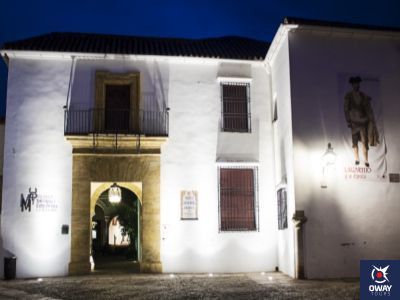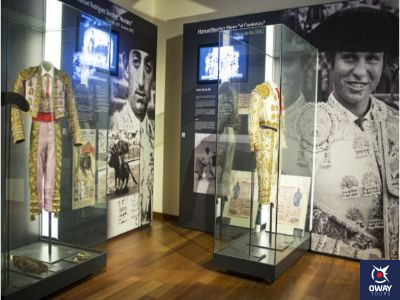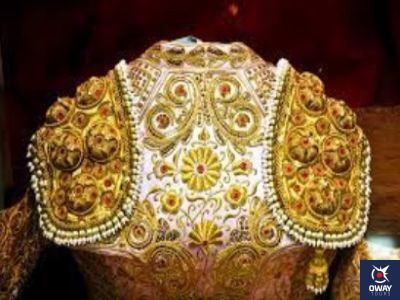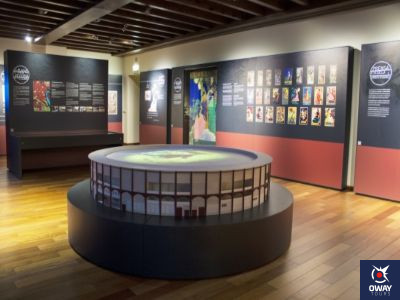Cordoba has always been and still is a bullfighting city, due to its history and culture. This museum is the public space that reflects this part of the city’s history.
It is located in the Plaza Maimónides, in an old 16th century stately mansion, in the Mudejar style, known as “Casa de las Bulas” (House of the Bulls). It is very close to the Hospital del Cardenal Salazar. Besides being in the Jewish quarter where one of the most famous monuments of the city, the Mosque, is located. If you want to know all the history and secrets of it, don’t forget to take our guided tour of the Mosque.
This museum is dedicated to the five bullfighting caliphs of Cordoba, Lagartijo, Guerrita, Machaquito, Manolete and Manuel Benítez (El Cordobés). There is also a section dedicated to the bullfighter Antonio Cañero. You will enjoy a tour of its beautiful courtyards and rooms through photographic material, bullfighting costumes, engravings, sculptures, paintings, old bullfighting posters, showing the history of bullfighting closer to the visitor.
If you are a fan of bullfighting, a visit is a must, as Cordoba is the birthplace of great bullfighters.
History of the museum
Its origins date back to 1948, when Cordoba hosted an exhibition of bullfighting art that seduced bullfighting lovers, arousing great interest among the people of Cordoba. Some time later there was a second exhibition dedicated to Machaquito, which was also a great success with the locals.
As a result of these events, the mayor of the city decided to dedicate a space to the bullfighting tradition. The City Council of Cordoba bought the Casa de las Bulas on 30th May 1954. The result was the “Museo Municipal de Artes Cordobesas y Artes” dedicated to the culture of the province, flamenco, Cordovan leather and traditional gold and silver work. In addition to some pieces related to bullfighting.
In 1983 it became a museum exclusively dedicated to bullfighting, closing in 2005 for various restorations.
It was not until 2014 that the Bullfighting Museum of Cordoba reopened its doors to the public, offering a space dedicated to bullfighting in a 16th century Mudejar building.

Collections
- Room 1. Cordoba, a city with a bullfighting aroma.
This is the first room in the museum, located on the ground floor next to the reception, the cloakroom and the shop. In this room you will find information about the bullfighting venues in the city and its surroundings. Bullrings, monuments, bullfighting shops, bullfighting circuits, bullfighting ranches, etc. You will discover the history of bullfighting in Cordoba.
- Room 2. The bull, bullfighting and bullfighting culture.
This room is dedicated to an impressive audiovisual show of historical and contemporary images showing the fierce confrontation between man and bull. They serve as an introduction to what the visitor will find in the museum.
- Room 3. The landscape of the bull.
Located on the first floor, this room presents the landscapes of the bull. All its most important characteristics, the livestock and its associated objects to complete this vision of nature. There are several examples of bulls’ heads, selected according to their history, as well as prints and lithographs of great value.
- Room 4. Five caliphs, five universes.
This room pays tribute to the great bullfighters that Cordoba has had. Five pedestals and the famous rejoneador, where their bullfighting costumes and some pieces associated with them, El Lagartijo, Guerrita, Machaquito, Manolete, El Cordobés and Cañero are exhibited.
- Room 5. The bullfight: the liturgy and the fiesta.
This is one of the most expressive rooms. Here you can discover the world of bullfighting from the inside. Another audiovisual show is presented in a circular form, as if you were in the middle of the bullring, which puts you right in the heart of the fiesta. You will be in an alternative day, among the audience, pasodobles and bugle calls.
Following on from another room, dedicated to the sagas of Cordoba, to other great bullfighters from Cordoba.
- Room 6. A long history: Cordoba and bullfighting.
This room is dedicated to the relationship between Cordoba and bullfighting. A relationship with several centuries of history. It shows the sites used in the bullfights, a model of the current bullring, as well as other elements to continue learning about the importance of its culture. It also dedicates a space to the work of the bullfighting school and the influence of bullfighting in America.
- Room 7. Bullfighting culture: artistic inspiration.
This room is dedicated to showing the museum’s collection of artistic pieces inspired by bullfighting. They show how this theme has been the inspiration for various works of art, paintings, sculptures, ceramics, among others. You can find works by Julio Romero de Torres, Juan Polo, Pellicer, etc.
- Room 8. Temporary exhibition room.
This room contains all the pieces that cannot be exhibited permanently, as well as hosting temporary exhibitions to vary the Museum’s collections, which are continually being renewed.

Opening times and prices
Opening hours
In winter, the museum is open from Tuesday to Friday from 8:30 am to 8:45 pm, Saturdays from 8:30 am to 4:30 pm and Sundays and public holidays from 8:30 am to 2:30 pm. The museum is closed on Mondays.
In summer it is open from Tuesday to Saturday from 8:30 am to 3:00 pm and on Sundays and public holidays from 8:30 am to 2:30 pm. It is closed on Mondays.
The last access to the museum is five minutes before closing time.
Price
General admission to the museum is 4€. There are discounts for students, so the entrance fee is €2. For children under the age of 13, admission is free.

How to get there
The Bullfighting Museum of Cordoba is located in Plaza de Maimonides 3, s/n 14004. It is located in the Jewish Quarter, in the heart of the historic centre. The best way to get to the museum is to go for a walk, enjoying the wonderful views of the Jewish Quarter.
If you come by car, I recommend parking in the Paseo de la Victoria or in the area of Avenida de Cádiz.
Another option is by bus. There are several lines, depending on which part of the city you are coming from. Most of them usually go through the city centre. The closest bus stops are República Argentina, Glorieta Cruz Roja, Claudio Marcelo, Diario Córdoba or San Pablo.


